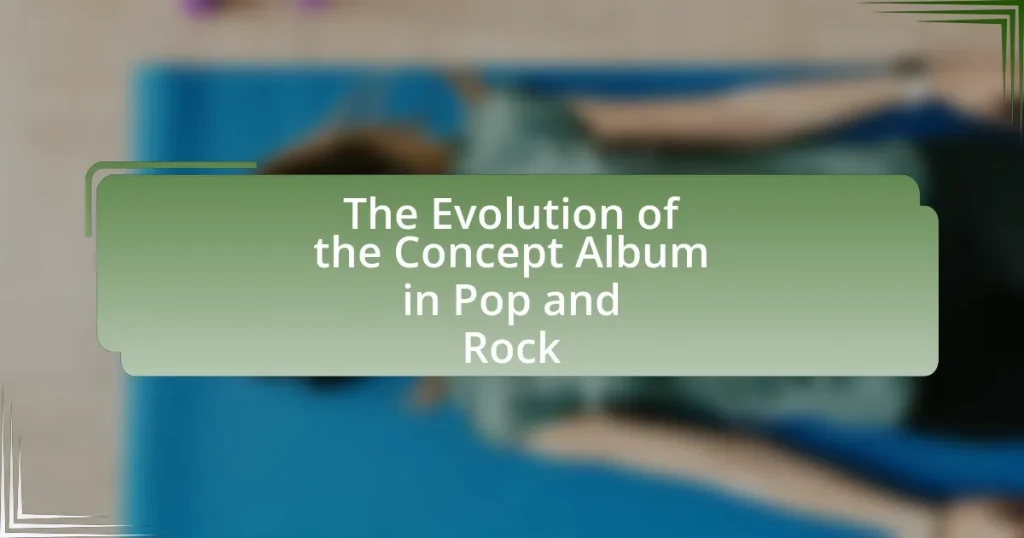The concept album in pop and rock is defined as a music album where all songs are unified by a common theme or narrative, creating a cohesive listening experience. Originating in the 1960s, notable examples include The Beatles’ “Sgt. Pepper’s Lonely Hearts Club Band” and Pink Floyd’s “The Wall,” which showcase the artistic ambitions of musicians during that era. The article explores the defining characteristics of concept albums, their significance in the evolution of music, and their impact on artists and listeners. It also examines key milestones, production techniques, and how modern concept albums continue to reflect societal themes and innovative storytelling methods.

What is the Concept Album in Pop and Rock?
A concept album in pop and rock is a music album where all the songs are unified by a common theme, story, or idea, creating a cohesive narrative or experience. This format allows artists to explore complex themes and emotions, often resulting in a more immersive listening experience. Notable examples include Pink Floyd’s “The Wall,” which tells a story of isolation and alienation, and The Beatles’ “Sgt. Pepper’s Lonely Hearts Club Band,” which presents a fictional band and explores various musical styles. The concept album format gained prominence in the 1960s and 1970s, reflecting the artistic ambitions of musicians during that era.
How did the concept album originate in these genres?
The concept album originated in pop and rock genres as a cohesive artistic expression that tells a story or explores a theme throughout its tracks. This development began in the 1960s, notably with The Beatles’ “Sgt. Pepper’s Lonely Hearts Club Band,” which integrated diverse musical styles and lyrical narratives, setting a precedent for future albums. Additionally, artists like Pink Floyd with “The Dark Side of the Moon” further solidified the concept album format by creating a continuous listening experience that conveyed complex themes and emotions. These albums demonstrated that music could transcend individual songs, establishing a new standard for artistic ambition in the genres.
What are the defining characteristics of a concept album?
A concept album is defined by its cohesive theme or narrative that runs throughout the entire work, often exploring a specific story, idea, or emotional journey. This thematic unity distinguishes concept albums from traditional albums, where songs may not be interconnected. Additionally, concept albums typically feature a deliberate arrangement of tracks that enhances the overall narrative, creating a seamless listening experience. Historical examples, such as Pink Floyd’s “The Wall” and The Who’s “Tommy,” illustrate how these albums utilize musical motifs and lyrical continuity to reinforce their central themes, thereby solidifying their status as concept albums.
How does a concept album differ from a traditional album?
A concept album differs from a traditional album in that it is designed to tell a cohesive story or explore a specific theme throughout its tracks. Traditional albums typically consist of a collection of songs that may not be related to each other, allowing for varied styles and subjects. Concept albums, such as Pink Floyd’s “The Wall,” are structured to create a narrative arc or thematic continuity, often enhancing the listening experience through interconnected lyrics and musical motifs. This format has been recognized as a significant artistic approach in music, with notable examples emerging since the 1960s, illustrating the evolution of storytelling in pop and rock music.
Why are concept albums significant in the evolution of music?
Concept albums are significant in the evolution of music because they represent a shift from individual songs to cohesive narratives, allowing artists to explore complex themes and storytelling. This format emerged prominently in the 1960s with albums like The Beatles’ “Sgt. Pepper’s Lonely Hearts Club Band,” which integrated music with a unified concept, influencing subsequent genres and artists. The success of such albums demonstrated that music could convey deeper artistic expressions, leading to a broader acceptance of albums as complete works rather than mere collections of singles. This evolution has shaped the creative landscape of pop and rock, encouraging musicians to innovate and push boundaries in their artistic endeavors.
What impact have concept albums had on artists and listeners?
Concept albums have significantly influenced both artists and listeners by fostering creative expression and enhancing narrative depth in music. For artists, these albums provide a platform to explore complex themes and cohesive storytelling, allowing them to push artistic boundaries; for instance, Pink Floyd’s “The Wall” and The Who’s “Tommy” are seminal works that showcase this narrative approach. Listeners benefit from the immersive experience that concept albums offer, as they encourage deeper engagement with the music and its themes, often leading to a more profound emotional connection. Research indicates that albums like “Sgt. Pepper’s Lonely Hearts Club Band” by The Beatles not only revolutionized the music industry but also shaped listener expectations for thematic coherence in albums, demonstrating the lasting impact of concept albums on both the creation and consumption of music.
How have concept albums influenced the music industry as a whole?
Concept albums have significantly influenced the music industry by shifting the focus from individual hit singles to cohesive artistic narratives. This transformation began in the 1960s with albums like The Beatles’ “Sgt. Pepper’s Lonely Hearts Club Band,” which showcased the potential for storytelling through music, leading to a greater emphasis on album-oriented rock. The success of such albums encouraged artists to explore thematic depth and complex arrangements, resulting in a new standard for creativity and production quality in the industry. Furthermore, concept albums have fostered a culture of artistic experimentation, as seen in Pink Floyd’s “The Wall” and David Bowie’s “The Rise and Fall of Ziggy Stardust and the Spiders from Mars,” which not only expanded musical boundaries but also influenced marketing strategies, concert performances, and the overall perception of albums as a complete artistic expression rather than mere collections of songs.

What are the key milestones in the evolution of the concept album?
The key milestones in the evolution of the concept album include the release of “Sgt. Pepper’s Lonely Hearts Club Band” by The Beatles in 1967, which is often credited with popularizing the format, and “The Wall” by Pink Floyd in 1979, which showcased a narrative-driven approach. Additionally, “Tommy” by The Who in 1969 is recognized as one of the first rock operas, establishing a precedent for storytelling in albums. These albums collectively marked significant advancements in the artistic and thematic depth of music, influencing countless artists and genres thereafter.
Which early albums set the stage for the concept album format?
The early albums that set the stage for the concept album format include “Sgt. Pepper’s Lonely Hearts Club Band” by The Beatles and “The Who Sell Out” by The Who. “Sgt. Pepper’s Lonely Hearts Club Band,” released in 1967, is often credited as the first true concept album, as it presents a cohesive narrative and thematic continuity throughout its tracks. Similarly, “The Who Sell Out,” released in 1967, employs a radio broadcast format and satirical advertisements, creating a unified artistic statement. Both albums significantly influenced the development of the concept album genre in popular music.
What themes and narratives were explored in these early concept albums?
Early concept albums explored themes such as identity, societal issues, and personal experiences. For instance, “The Who’s” “Tommy” delves into the struggles of a deaf, dumb, and blind boy, reflecting on themes of trauma and redemption. Similarly, “Pink Floyd’s” “The Dark Side of the Moon” addresses mental health and the pressures of modern life, showcasing narratives that resonate with existential concerns. These albums often employed a cohesive storyline or thematic continuity, allowing artists to convey complex messages and emotions through their music.
How did the production techniques evolve during this period?
During this period, production techniques evolved significantly with the introduction of multi-track recording, which allowed for greater complexity and layering in music. This advancement enabled artists to experiment with soundscapes and create cohesive narratives within concept albums, as seen in works like Pink Floyd’s “The Dark Side of the Moon,” which utilized innovative studio effects and sound manipulation. Additionally, the use of synthesizers and digital technology became prevalent, further enhancing the creative possibilities for musicians and producers. These changes facilitated a shift from traditional recording methods to more experimental approaches, allowing for a richer auditory experience that defined the concept album genre.
What role did cultural and technological changes play in this evolution?
Cultural and technological changes significantly influenced the evolution of the concept album in pop and rock music. The rise of the counterculture movement in the 1960s, alongside advancements in recording technology, allowed artists to experiment with longer formats and thematic coherence. For instance, the introduction of multi-track recording enabled musicians to layer sounds and create more complex arrangements, as seen in albums like “Sgt. Pepper’s Lonely Hearts Club Band” by The Beatles, which integrated diverse musical styles and narrative elements. Additionally, the shift from singles to albums as the primary medium for artistic expression reflected changing consumer preferences and cultural values, emphasizing storytelling and artistic vision over commercial hits. This interplay of cultural shifts and technological innovations established the concept album as a legitimate and influential form in the music industry.
How did the rise of rock and pop music in the 1960s influence concept albums?
The rise of rock and pop music in the 1960s significantly influenced the development of concept albums by encouraging artists to create cohesive narratives and thematic explorations within their work. This era saw musicians like The Beatles and The Beach Boys experimenting with album formats that transcended traditional song collections, exemplified by The Beatles’ “Sgt. Pepper’s Lonely Hearts Club Band,” which is often cited as a pioneering concept album that integrated diverse musical styles and storytelling elements. The success of such albums demonstrated the commercial viability of this format, prompting other artists to adopt similar approaches, thereby solidifying the concept album as a legitimate artistic expression in popular music.
What technological advancements contributed to the development of concept albums?
Technological advancements such as the introduction of multi-track recording, the development of vinyl records, and the evolution of stereo sound significantly contributed to the development of concept albums. Multi-track recording allowed artists to layer sounds and create complex arrangements, enabling a cohesive narrative throughout an album. The shift from mono to stereo sound provided a richer listening experience, enhancing the emotional impact of the music. Additionally, the longer playtime of vinyl records facilitated the inclusion of extended musical pieces and thematic continuity, which are hallmarks of concept albums. These advancements collectively transformed how music was produced and consumed, paving the way for the concept album format to flourish in the pop and rock genres.

How have modern concept albums transformed the genre?
Modern concept albums have transformed the genre by integrating cohesive narratives and thematic depth, elevating the listening experience beyond individual tracks. This transformation is evident in works like Kendrick Lamar’s “To Pimp a Butterfly,” which explores complex social issues through interconnected songs, and Pink Floyd’s “The Wall,” which presents a rock opera format that tells a continuous story. These albums have influenced artists across genres to prioritize storytelling and emotional engagement, leading to a resurgence of the concept album format in contemporary music. The impact is measurable; for instance, the rise of streaming platforms has allowed listeners to engage with entire albums as singular artistic statements, rather than just collections of singles, thus reshaping how music is consumed and appreciated.
What are some notable contemporary concept albums in pop and rock?
Notable contemporary concept albums in pop and rock include “The Age of Adz” by Sufjan Stevens, which explores themes of love and loss through a blend of orchestral and electronic music. Another significant album is “To Pimp a Butterfly” by Kendrick Lamar, which addresses racial inequality and personal struggles, utilizing a mix of jazz, funk, and hip-hop elements. Additionally, “American Idiot” by Green Day critiques American society and politics through a punk rock lens, while “The Suburbs” by Arcade Fire reflects on suburban life and nostalgia. Each of these albums has received critical acclaim and showcases the evolving narrative capabilities of the concept album format in contemporary music.
How do these albums reflect current societal themes and issues?
These albums reflect current societal themes and issues by addressing topics such as mental health, social justice, and political unrest. For instance, many contemporary concept albums incorporate narratives that explore the impact of systemic racism and inequality, as seen in works like Kendrick Lamar’s “To Pimp a Butterfly,” which delves into the African American experience and critiques societal structures. Additionally, albums like Billie Eilish’s “When We All Fall Asleep, Where Do We Go?” tackle themes of anxiety and existential dread, resonating with a generation grappling with mental health challenges. These thematic explorations are supported by statistics indicating rising mental health issues among youth, with the National Institute of Mental Health reporting that 1 in 5 U.S. adults experience mental illness. Thus, the content of these albums serves as a reflection of and commentary on pressing societal issues.
What innovative storytelling techniques are used in modern concept albums?
Modern concept albums utilize innovative storytelling techniques such as nonlinear narratives, multimedia integration, and character development. Nonlinear narratives allow artists to present stories out of chronological order, creating a more immersive experience; for example, “The Wall” by Pink Floyd employs this technique to explore themes of isolation and trauma. Multimedia integration involves combining music with visual elements, such as videos or artwork, enhancing the storytelling; an example is “Lemonade” by Beyoncé, which pairs songs with a short film to deepen the narrative. Character development is also prominent, where artists create personas or characters that evolve throughout the album, as seen in “The Rise and Fall of Ziggy Stardust and the Spiders from Mars” by David Bowie, which tells the story of an alien rock star. These techniques collectively enrich the narrative depth and engagement of modern concept albums.
How do artists approach the creation of a concept album today?
Artists today approach the creation of a concept album by integrating storytelling with musical composition, often using thematic narratives that resonate with contemporary issues. This method allows artists to explore complex ideas and emotions, creating a cohesive listening experience that engages audiences on multiple levels. For instance, albums like “To Pimp a Butterfly” by Kendrick Lamar and “The Age of Adz” by Sufjan Stevens exemplify how modern artists weave personal and societal themes into their work, reflecting current cultural dialogues. Additionally, advancements in technology enable artists to experiment with soundscapes and production techniques, further enhancing the narrative depth of their concept albums.
What collaborative processes are involved in producing a concept album?
Producing a concept album involves several collaborative processes, primarily including songwriting, arrangement, recording, and production. Songwriters typically work together to develop a cohesive narrative or theme, ensuring that each track contributes to the overall concept. Musicians collaborate during arrangement sessions to decide on instrumentation and song structure, which enhances the thematic continuity. Recording sessions require collaboration between artists, producers, and sound engineers to capture the desired sound and atmosphere, often involving multiple takes and adjustments. Additionally, visual artists may collaborate on album artwork and promotional materials to visually represent the concept, further solidifying the album’s theme. These collaborative efforts are essential for creating a unified artistic statement, as seen in landmark concept albums like Pink Floyd’s “The Wall” and The Who’s “Tommy,” where teamwork across various disciplines resulted in critically acclaimed works.
How do artists balance artistic vision with commercial viability?
Artists balance artistic vision with commercial viability by strategically integrating personal expression with market trends. This involves understanding audience preferences while maintaining authenticity in their work. For instance, successful artists often analyze sales data and streaming metrics to identify popular themes or sounds, allowing them to craft music that resonates with listeners without compromising their unique style. A notable example is the album “The Dark Side of the Moon” by Pink Floyd, which achieved commercial success while exploring complex themes, demonstrating that a well-executed artistic vision can attract a broad audience.
What practical tips can aspiring musicians consider when creating a concept album?
Aspiring musicians should focus on a cohesive narrative when creating a concept album, as this unifies the songs and enhances the listener’s experience. Developing a clear storyline or theme allows for deeper emotional engagement and can guide the songwriting process. Additionally, structuring the album with intentional transitions between tracks can create a seamless flow, making the listening experience more immersive. Research indicates that albums with strong narratives, such as Pink Floyd’s “The Wall,” have resonated deeply with audiences, demonstrating the effectiveness of this approach. Finally, considering the visual and promotional aspects, such as album artwork and music videos, can further reinforce the concept and attract listeners.




